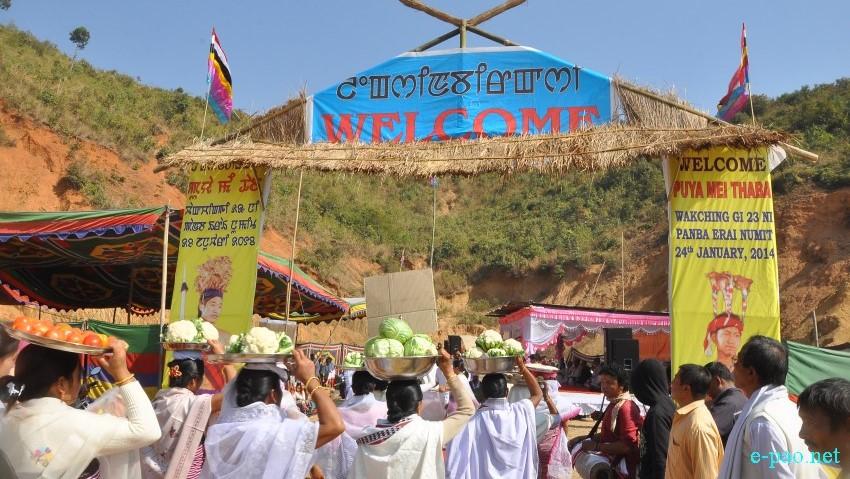How the Concept of ‘Pure-Impure’ Took Roots in Manipur After the Burning of Meitei Puya

Image Courtesy: E Pao
Shantidas Gosai, the Hindu missionary who came to Manipur in the early 18th century, burnt the Puya – the sacred scripture of Meiteis -- after converting them to Hinduism. The burning of Meitei Puya assaulted the culture, language, religion and social harmony of Manipur. After the advent of Hinduism in Manipur, the concept of ‘pure’ and ‘impure’ among sections of the society has deeply affected the lives of people in the North-Eastern state.
The existence of caste within the Meitei society has always been denied by people in the state, because the people of Manipur do not like being labeled along with the so-called ‘untouchables’ of India. But, the practice and symptoms of caste are visible in every part of life in Manipur -- from birth till the end of life.
Of late, the words “Amang and Asheng” in Manipuri, meaning “pure and impure” in English, have become a topic of debate in the social media. The words for ‘casteism’ and ‘untouchability’ used by Manipuris are also "Amang-Asheng".
The concept of ‘pure and impure’ blood by birth is rather close to the description of casteism in Vedic scriptures.
But, it was after the Bharatiya Janata Party-led Central government attempted to insert the Hindutva machinery in Manipur University, which was accepted by the state government, that the talk about practices of ‘pure and impure’ (Amang-Asheng) became a hot topic in social media among the people of Manipur. This was further fuelled by rumours about the construction Rash Lila Mandop within the sacred premises of Kangla, which appalled the people who wanted to preserve Kangla for Sanamahism (the indigenous religion of the Meiteis).
Did Amang-Asheng exist before the advent of Hinduism in Manipur?
Since the past 20 years, I have been addressing casteism and its impact on the life of people in Manipur. Each time I identify caste as a problem, I am accused of bringing casteism to Manipur. However, the attempt from my side has been to help the people understand the practice of caste among a section of Manipur’s society.
Brahmins not eating food cooked by other communities, no marriages between Brahmins and Meiteis and other communities, restrictions on temple entry for non-Brahmins are very real issues in Manipur. Yet, these are not seen as caste issues.
Before Hinduism made its way into Manipur, the Meiteis, as well other communities in the state, had the concept of sacred places, sacred days and sacred events. The sacredness or sanctity of the belief system of Meiteis is different from untouchability or the caste system. However, their belief system got mixed up with the practice of casteism or untouchability after adoption of Hinduism.
Amang-Asheng is rather an appropriate word for a confused and mixed concept of casteism and untouchability.
The concept of a Brahmin becoming defiled if touched by an ‘untouchable’, the practice of Brahmins not eating food cooked by so-called‘untouchables’ never existed in Manipur. Now, this has become part of life in the state.
Marriages between people from the valley with those on the hills have been in practice throughout the history of Manipur. The kings of both the valley and hills used to have wives from both areas. There was no concept of ‘untouchability’, such as the Meiteis becoming defiled by marrying tribal women. Now, Shudhhikaran in Hindi and Shengdokpa in Manipuri are words used for a ‘purification’ ceremony held after a man marries a tribal woman. This practice never existed in Meitei society prior to the adoption Hinduism.
‘Untouchability’ has now become a part of life in Manipur. A Meitei marrying a tribal woman has to go through a purification ceremony in either of the two forms. One, is the old practice of making the tribal woman concerned drink cow dung mixed with water or cow urine. The other form of purification is to ask the tribal woman concerned to drink holy water collected after washing the feet of Brahmins, known as pavitra choran (the holy feet of Brahmins).
Until the purification ceremony takes place, the Meitei man and the tribal woman remain unclean, and the parents of the man do not allow the woman to enter their kitchen. If the parents of the man happen to die, both the man and the tribal woman he married, are not allowed to perform the rituals.
These social taboos never existed among the societies of Manipur before the advent of Hinduism. Amang-Asheng has become worse among the Meiteis, and is not restricted to just marriages between Brahmins and Meiteis. It has extended to general Meiteis and Scheduled Caste communities, as well as the hill people.
(Madhu Chandra is National Secretary of All India Confederation of SC/ST Organisations based at Hyderabad.The views are personal.)
Get the latest reports & analysis with people's perspective on Protests, movements & deep analytical videos, discussions of the current affairs in your Telegram app. Subscribe to NewsClick's Telegram channel & get Real-Time updates on stories, as they get published on our website.
























